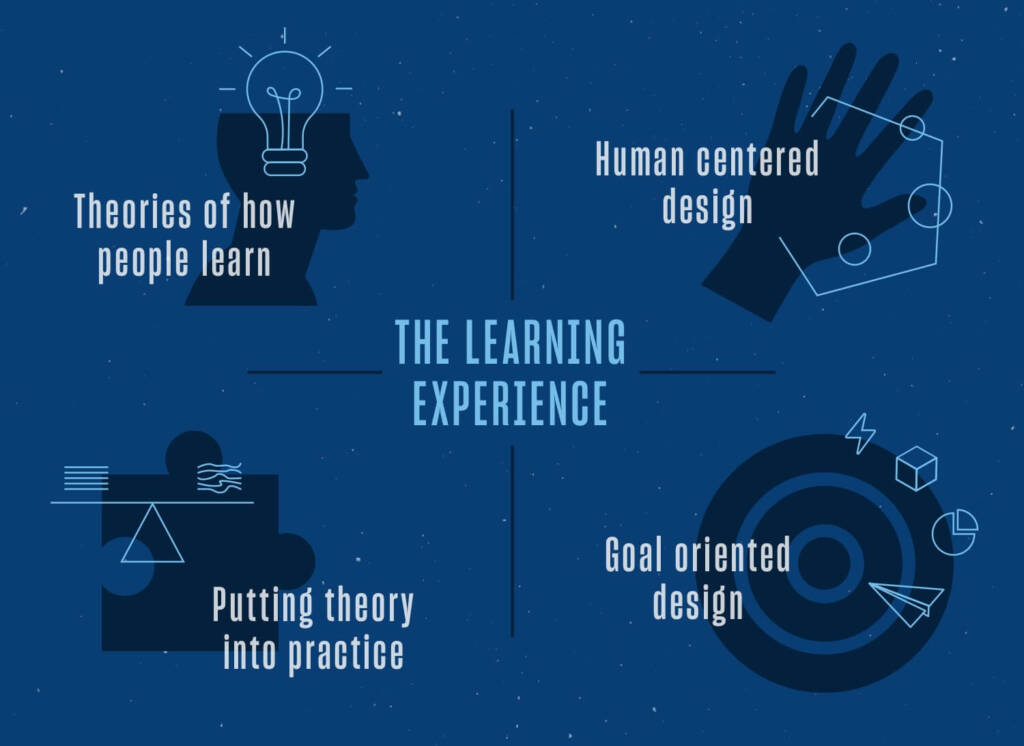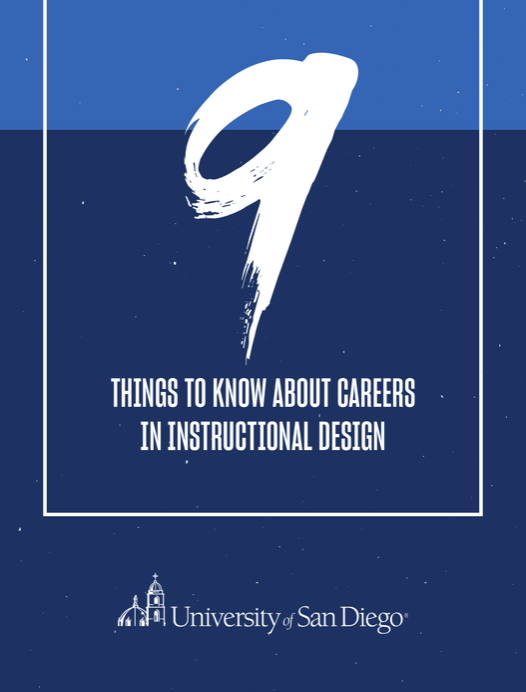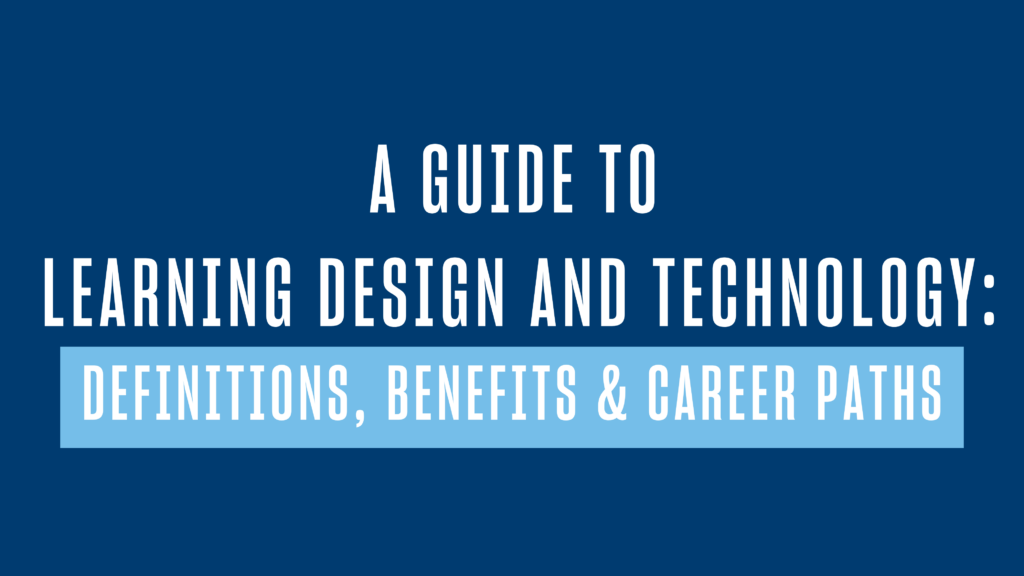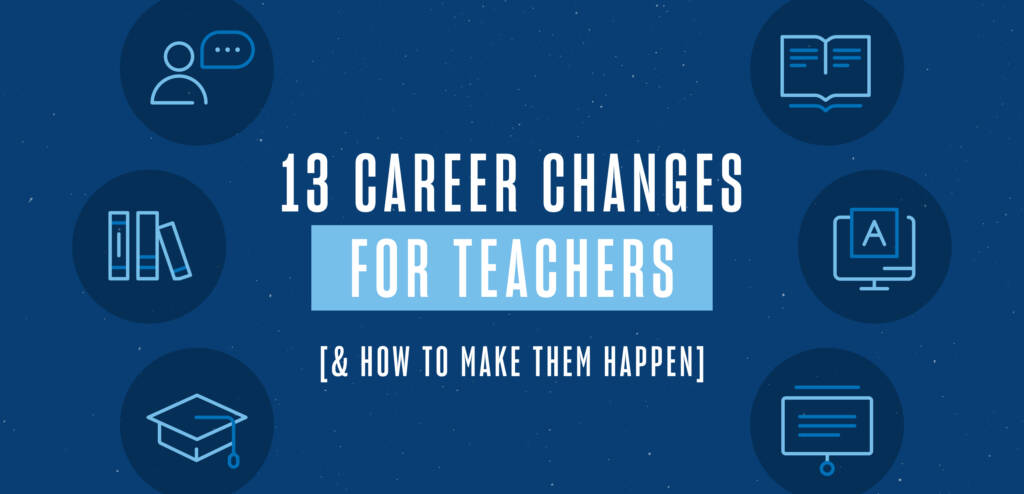If you’re looking at getting into the field of learning design, you may have heard the term “learning experience design” (LXD) but may be a little fuzzy about what it means. There can be some confusion about the distinction between LXD and instructional design and what distinguishes a learning experience designer from other similar careers in training and education.
Learning experience design is a term that evolved out of design fields (such as interactive design, graphic design, and user experience design) applied to instructional design, making the process more learner-centered. This post explores what makes LXD unique, how it relates to the rest of the learning and education field, and whether pursuing LXD is the right career path for you.
What Is Learning Experience Design?
LXD is a process used to create learning experiences for education and training that places learners at the center of intended goals and objectives.
The term learning experience design gained prominence in the 2000s with the work of Niels Floor. His learning experience design website LXD.org describes LX design as interdisciplinary design — meaning it incorporates elements from different user design disciplines (e.g., interaction design, user experience design, graphic design) and learning disciplines (e.g., cognitive psychology, neuroscience, instructional design).
As a process, LXD intentionally shapes the learning experience so that each learner can see how the training solution or course reflects their immediate needs and allows them to achieve desired learning outcomes.
Designing learning experiences draws upon four foundations:
- Theories provide LX designers with insights into best design practices related to behavioral motivators, cognitive science, and experiential learning that help them design solutions based on how people learn.
- Human-centered design guides the development of experiences people can relate to and connect with on a personal, cognitive, and emotional level. It’s an approach that considers the human perspective in all design process steps.
- Goal-oriented design focuses on creating experiences that serve a clear purpose related to learning needs and expected outcomes.
- Putting theory into practice involves iterative design. Prototyping the learning experience and receiving feedback from learners provides LX designers with valuable data about how learners approach the material, which they use to improve the design before implementation.
[PDF GUIDE] Want to create meaningful learning experiences? See how instructional design brings ideas to life.

How Is Learning Experience Design Different from Instructional Design?
While both approaches use human-centered design principles (such as user research and knowing your audience) to help people achieve specific goals, instructional design (ID) focuses more on instruction. In contrast, LXD is more focused on the learner.
ID has its roots in training, dating back to World War II. It draws on learning theories and theoretical frameworks to develop instructional solutions to institutional and organizational learning and development needs. Psychologists developed ID as a systematic process focused on delivering instruction in a manner that is as efficient as it is effective. The ID process is replicable across numerous industries and utilized for various training and learning experiences.
LXD comes from creative and user-experience design and centers the learners as the focus of design decision-making regarding content, prototyping, feedback, iteration, implementation, and evaluation. People often consider LXD a comparatively more creative process than ID because it heavily emphasizes rapid prototyping and continuous revision to improve the learning experience.
According to LXD.org, you can think of the distinctions between LXD and ID along the following areas:
| Learning Experience Design | Instructional Design | |
| Perspective | Field of Design | Field of Learning |
| Skills | Creative, artistic, design | Analytical, methodical, scientific |
| Methods | Creative mindset with a design approach | Analytical mindset with a scientific approach |
| What You’re Designing | An experience | Courses and curriculum |
How Does Learning Experience Design Compare to Learning Design?
Learning designers and LX designers place learners as their top priority but differ in their approach and tools. LX Designers emphasize the learner and the overall context of the learning experience that centers on their needs and preferences. Learning Designers (LD) focus more on creating a structured and effective learning experience, typically by utilizing instructional design principles, learning theories, and assessment strategies that measure learning outcomes.
How Is Learning Experience Design Different from User Design?
User experience design (UXD) is about the interaction users have with the experience of using a product or service. UX designers are concerned with seamless navigation and functionality, whereas LX designers want to ensure that learners take something away from their experience. A UX designer will ask questions about usability and functionality, such as:
- Can users easily navigate a website?
- Do users have physical difficulty operating a tool?
- Are the steps in a process clear and concise?
While LXD uses some UXD elements — for example, both use personas to understand the needs and challenges facing a user/learner — the scope of LXD is much broader to encompass the background, skills, knowledge, and conditions of the learning environment.
What Does a Learning Experience Designer Do?
An LX designer is responsible for creating engaging and compelling learning experiences for educational purposes and workplace training. In general, an LX designer will:
- Conduct user research to assess the needs of learners. The goal of the learning experience design process is to find out as much as possible about learners to connect with them personally and emotionally. LX Designers administer surveys and conduct interviews to develop personas they can use to understand learners’ essential needs.
- Apply an empathetic, learner-centered approach to create effective solutions. The LX designer will use their knowledge of instructional design models and learning theories to determine how to create a learning experience that helps learners achieve the established goals.
- Account for inclusive practices. Every learner is different, and their age, culture, language, and range of abilities can affect the learning experience. Learner personas help LX designers account for the various characteristics learners have.
- Collaborate with other professionals. LX designers will work with various stakeholders to create and design courses and learning materials. Aside from interviewing subject matter experts, they may coordinate with other professionals, such as instructional designers, curriculum designers, graphic designers, and instructional technologists.
- Utilize technology to enhance the learning experience. Design tools, such as content authoring software and learning management systems, are essential for building courses. An LXD may use digital media elements such as video, audio, or gamification design tools to make experiences more interactive and immersive.
- Develop assessment tools to evaluate the effectiveness of learning programs. To determine if the learners gained the intended knowledge or skills, LX designers will collect data and apply metrics to measure outcomes. These actions are part of the iterative design process designers use to get successively closer to meeting the needs of all learners.
[RELATED RESOURCE] Curious about cutting-edge tools? Learn how instructional design prepares you to design innovative programs.
What Are Some Learning Experience Design Jobs?
LX designers work in education or for private corporations to design, develop and implement training programs and courses. LX designers may also be sought after to develop learning processes for:
- Mobile applications
- Websites
- Software
- Extra-curricular programs
- Non-profit educational causes
- Media products such as digital games, toys or interactive videos
As LXD is a newer field compared to ID, there is often some overlap in listed job descriptions. Search results for LXD jobs can display positions described as learning experience designer, learning designer, user experience designer, instructional designer or even hybrid positions. A search for LXD positions can yield results across many industries*, including:
- Higher education — Boston College, Northeastern University, Columbia University
- Training and eLearning — Anchored Training, Kaplan, BITCADET
- Healthcare — Cambia Health, UnitedHealth Group, Elevance Health, Hanger, Inc
- Retail and tech companies — Amazon, Ericsson, allen interactions
*Listed companies are based on a May 2023 search on multiple job aggregation sites
If you’re interested in learning experience design and are flexible about the title and general responsibilities, other possible career paths include:
- Learning Architect — Supports the development of learning solutions by adapting content for online instruction, developing course materials, establishing metrics to measure learning outcomes and incorporating learning technologies.
- Associate Training Director — Oversees the design and implementation of training programs, identifies training needs to meet established learning goals, manages staff and the training budget.
- Training and Development Specialist — Plans, conducts and administers education or training programs, evaluates current training programs and researches possible new technology tools and resources.
For a list of other possible career paths see our deep dive into ID careers.
What Is a Learning Experience Designer’s Salary?
According to Salary.com, as of May 2023, the average Learning Experience Designer salary in the United States is $102,450. You can expect the salary range to fall between $86,468 and $117,844 depending on level of education, certifications, additional skills and the number of years you have spent in your profession.
How Do I Become a Learning Experience Designer?
Many of the skills that benefit an instructional designer are also essential for learning experience design jobs.
- Knowledge of instructional models and frameworks. LX designers can better inform their design by understanding instructional design models and theoretical frameworks of learning. LXDs can take instructional design courses offered by higher education programs, such as educational technology or learning design. They can also pursue professional development opportunities such as learning experience design certificates.
- Experience with tools and technologies. An LX designer must know how to use design tools and educational technology to develop content. Aside from experience with tools such as course authoring software and learning management systems, it’s essential to be comfortable working with industry-standard tech and media tools, such as Google Suite, Microsoft 365, and Adobe Creative Cloud platforms.
- Master your soft skills. Even if you’re never in front of a classroom or facilitating training, as an LX designer, you’ll benefit from a mastery of soft skills, including good communication, organization, and critical thinking. An aspiring LX designer can refine these skills in a degree program and workplace environment.
- Join a professional organization. Contacts and resources are vital for helping you find information, ask for feedback, stay on top of the latest industry news, and explore what’s possible in the field. Joining organizations such as the Learning Guild, Training Magazine Network, or the Online Learning Consortium can help advance your career.
- Be innovative and flexible. Every training program will be different, and every learner will have unique needs. Developing human-centered design requires empathy, innovation, iteration, and an open mindset.
If you want to learn more about learning design principles and develop experience with industry-standard design tools — all while building professional connections and a personal project portfolio — consider our online Master of Science in Learning Design and Technology degree program. As part of our program, you’ll learn how to accurately and reliably assess the needs of various learner populations.
Have questions? Contact us to learn more about

![What is Learning Experience Design? [+ Career Paths]](https://onlinedegrees.sandiego.edu/wp-content/uploads/2023/06/ldt_blog_learningexperiencedesign.png)



